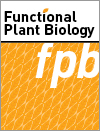FP24019Impact of exogenous melatonin foliar application on physiology and fruit quality of wine grapes (Vitis vinifera) under salt stress
 and Sheng Li
and Sheng Li 
In this study, by foliar spraying of 100 and 300 μmol L−1 melatonin, the results showed that melatonin was able to reduce the damage of salt stress on the photosynthetic system and antioxidant system of wine grape (Vitis vinifera) leaves, and also improve the shape of the fruit and the intrinsic quality of the grape berries, such as sugar, acid, and nitrogenous compounds. Melatonin at 100 μmol L−1 was found to be the most effective.




